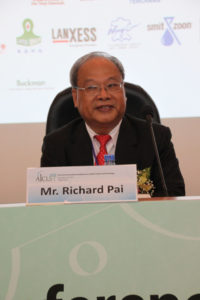POSTED ON
An Alumni Event

It is easy to rush on and forget your friends in this modern world. Yet as we see China continue to rise in importance we all know how important connections – “guanxi” – are for moving forward in business. In the west we used to maintain our connections with Christmas cards and I can personally testify to their value in keeping me in touch with colleagues who were to be invaluable a couple of decades after we would otherwise have lost contact. Of course today we have LinkedIn doing the job, or at least something similar, and the University has its alumni association.
In Northampton the Corium group is one of the strongest alumni associations although with regular changes in the database structure we do appear to keep losing addresses, and the UK laws on how we can use and share data about people make it quite hard to get it updated. Given that leather does not involved huge numbers and is still a small industry my ambition would be to actually identify every single individual who studied in London and Northampton since 1908 and get a short biography written with a class photo or two involved. Since I studied at Leeds I would be quite keen for those students to be involved also, but I think that is a stage two.
Such a document would be a fine part of the world’s leather industry history in the era of chrome tanning. It was chrome tanning that drove the demand for trained leather chemists and hence it was the late 19thcentury and early 20th when the main worldwide colleges were founded. Wherever you travel today in the world you come across owners, managers and technicians who studied with us in the UK and it would be really good to build a proper record.
Time for Taipei

And so it was that we were in Taipei earlier this week at the 9th AICSLT Conference. AICSLT stands for Asian International Conference on Leather Science and Technology, and takes place every two years. This was the first time ever it has been to Taiwan and it was clear that the local tanners association (TILA) and the country were proud and delighted. This fabulous event was organised by George Huang who did a one year course in Northampton early in his career sponsored by the Taiwanese government and the Chairman of the organising committee was Richard Pai, another Northampton Graduate, who is the CEO of the famous tanning group Joinland/Tai Che. Nearly three hundred delegates attended this two and a half day technical conference and with Wolfram Scholz giving one lecture, Barry Wood from the BLC giving two and myself giving the AICSLT lecture on behalf of the University the UK was well represented.
It is important that the UK was present as in this important regional forum the representation from India and a number of Chinese Universities was considerable. They were present with senior staff and a cohort of students giving short papers on their research work. We view ourselves as leaders in research so these events are important occasions to keep our profile high amongst the world’s top tanners and chemical companies.
Avoid pushing the self destruct button
There was a heavy weighting of talks towards environmental matters – new tannages, carbon footprints, “natural dyes”, composting and all sorts of ways of handling tannery wastes and by-products. Very noticeable was the number of young researchers willing to put a simple statement in their slides that said “chrome is toxic”. So much so that past IULTCS President Prof Bi Shi from Sichuan University interrupted one Indian presenter to say that she should not make that sort of statement which just was not true. To be fair many of the Chinese presenters said something very similar. And Campbell Page became equally frustrated by papers explaining that current dyestuff technology involved banned substances, which he said no one had actually been using for over fifteen years. These are important areas as however hard we work on new tannages chromium will remain the major tanning process for a decade or more yet, and we all know that when done properly it is a good safe process. The last thing the leather industry can afford is our own academics and research students glibly telling the world that what we currently do is “toxic” or totally wrong in some other way. The leather industry has enough enemies to fight without trying to kill ourselves.
Mike Redwood
16th November, 2012